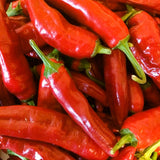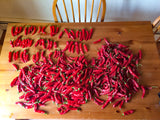Ole Pepperpot Pepper
Capsicum annuum
"PEPPER POT! STEAMING HOT!" Echoed the cries of Black Women food vendors throughout the bustling streets of 19th and early 20th century Philadelphia. This soup originated in West Africa and the Caribbean before making its way to our city. While the recipes for the famous soup that fed Philadelphians of all colors and classes varied with every cook, the best versions showcased the outspoken Pepper Pot Pepper! The botanical history of this bold capsicum is murky, though Dr. William Woys Weaver alludes to some connection to the Mexican Chiltepe pepper, a spicier relation perhaps that was used to flavor the Mexican tripe based soup named Mondongo. However it arrived North, it seems that Ole Pepperpot and its close botanical relatives were historically associated with the African American cooks who brought its fire to the homes and restaurants of Philadelphia. Notably the famous Black Philadelphia catering families, the Augustins and the De Baptistes had a hand in preserving the pepper as they bought and used it heavily in Pepper Pot Soup and other dishes.
Ole Pepperpot is green when immature, ripening to a slight golden blush starting at its curly tail before attaining its full red color. Of the species annuum, the plants grow to about 3½ feet (a tall pepper!) and sets fruit heartily until frost in the right conditions. Once harvested, the fruits may also be dried or pickled for preservation. We recommend this pepper for all lovers of heat (and it is hot) and especially for Philadelphians wanting to savor a piece of their historic city!
On her blog, Truelove Seeds grower Dorene Pasekoff of Hill Creek Farm describes this pepper well:
'Ole Pepperpot' Pepper (Capsicum annuum var. annuum) is the answer to the Mid-Atlantic grower who wants a bountiful harvest of genuinely hot peppers and wants to be able to save seed so that they can keep growing those peppers into the future.
'Ole Pepperpot' first ripens in August and continues prolifically until the first frost. The ripe red peppers (which look like a cayenne because, as William Woys Weaver related, it is one) actually produce enough of a harvest that the grower and the grower's entire extended family can eat all the hot peppers they like in season and still have enough to sell fresh, dried as pods or in cute little jars of dried hot pepper powder.
Read Dorene's full write-up here, with quotes from Dr. Weaver.
In 2022, Dorene grew this variety for our catalog and has passed it off to Amirah Mitchell to grow at Sistah Seeds, where she focuses on seed crops of the African Diaspora.
Days to maturity: 75-80
Seeds per pack: 20
Germination rate: 80% on 01/28/2025
Planting / harvesting notes
Start seeds indoors 8-10 weeks before the last frost and transplant into garden well after the danger of frost. Keep seedlings moist but do not overwater. Transplants should be initially watered in well, and plants will be most productive with regular irrigation and full sun.
Seed keeping notes
Peppers are generally self-pollinating, though we isolate different varieties of the same species by at least 50 feet, in hopes that flying insects will not cross pollinate them unexpectedly. There are several important species of peppers, so check your scientific names! Pepper seeds are ripe when the fruits have turned their final fiery color - in this case, fully red. Cut the fruit, scrape out seeds, and lay them out to dry on a labeled screen or paper product in a ventilated place away from direct sunlight for a week or two. Drying the peppers before seed extraction can slightly lower your germination rates, but works fine for home seed saving as long as the peppers do not rot.









